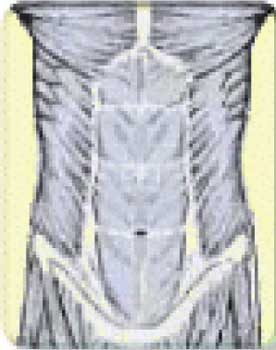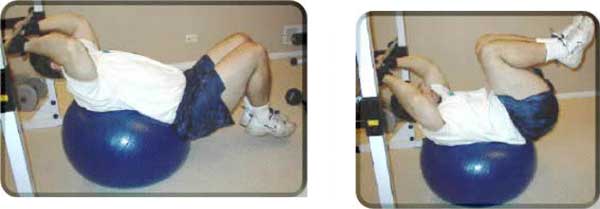Swiss Ball Leg Raises

Why Is This Exercise So Effective?
This exercise utilizes the instability and shape of the Swiss Ball to maximize the tension on the lower abs. It will affect mainly the lower abdominals but will hit the hip flexors to some degree.
How To Do It
- Set the ball about a foot in front of something solid (e.g. a Smith machine bar or dumbbell rack) that you can grab onto.
- Grasp above your head as you lie with your back on the ball. Your arms should be outside shoulder-width apart (the further apart you grasp, the more control over your body movement you will have).
- Keep your arms bent and ready to stabilize. This is best done with your knees bent to keep stress off the lower back.
- Take a deep breath let your legs down, wrapping your back around the ball, expanding the rib cage and getting a big stretch on the abs.
- Raise your legs up by rolling up the spine.
- Your pelvis should tilt up and off the ball until only your lower back is on the ball and your legs are up in the air.
- Squeeze hard, lower and repeat.
- You will experience a lot of side-to-side movement when doing this exercise due to the inherent instability of the ball. Keep a good grip on something solid!

How to incorporate this exercise into your workouts:
This exercise can be done anywhere in your abdominal training routine.
- It does require a great deal of stability, however, and I would recommend doing it before exercises that are in a more stable position, e.g. floor crunches.
Common Errors
1. Improper body placement
Your body should be angled slightly down with your glutes on the forward-facing surface of the ball. Placing yourself too high up will decrease the amount of resistance on your abs. Placing yourself too low on the ball will allow your feet to hit the floor before you can get an effective stretch on the abs at the bottom.
2. Using momentum
Do not allow yourself to use momentum or do the exercise quickly. This can throw off your balance, increasing the risk of straining your back and decreasing the effectiveness of the exercise.
Tricks
1. Altering resistance
You can alter the resistance by rolling forward or backward on the ball.
- The more vertical your lower back is at the start of the movement (more on the front face of the ball), the harder it is, while the more horizontal your lower back (more on the top of the ball), the easier it is.
- You can also try ankle weights or bending your knees more or less.
2. Isometric hold
To work your abs in an isometric hold, at the top of the leg raise, hold your legs up straight and vertical for several seconds.
- Your hips should be off the ball with only your lower back resting on it. Hold on tight.
- You can also roll the ball over to the left, keeping your feet pointed up (your legs will be angled over to the right to keep balance). Roll over to the other side. This works the sides well.
- Keeping your knees bent will make this easier. You may also try doing leg thrusts from this position as well. A thrust is where you push your legs up (you will look as though you are trying to put footprints on the ceiling).
3. Increasing instability
The best way to increase the instability of this exercise and improve its functional results is to place your hands closer together on what you are gripping. Your hands are your main stability point for this exercise and placing them closer together will decrease your base of support.
4. Use a smaller ball
Go to a discount store and pick up a small rubber ball about 18 inches in diameter. Make sure it is strong enough to support your bodyweight. The smaller ball increases the instability of the exercise, increasing its effect.


